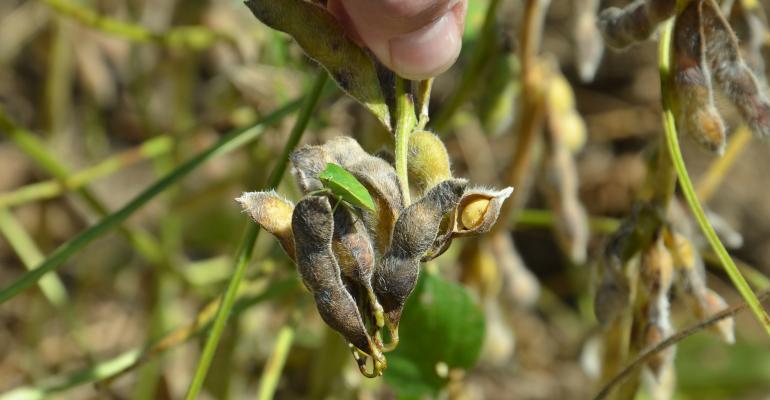Stinkbugs in 2019: What you should know

Soybean Pest Beat: Know when to scout and decide if you need to treat for stinkbugs.
May 29, 2019
Stinkbugs were a problem for us in 2018. Will they be here this year? When do I scout, and what do I do if I find them?
The Indiana certified crop advisers answering this question include Jamie Bultemeier, A&L Great Lakes Labs, Fort Wayne; Troy Jenkins, agronomist with Ceres Solutions, Rochester; and Marty Park, Great Lakes Seed Service, Rensselaer.
Bultemeier: Adult stinkbugs overwinter in protected areas. While last winter was cold, the elevated populations from 2018 may present themselves again in 2019. While stinkbug adults may be present all summer long, they only attack soybeans by feeding on pods. Thus, scouting begins in mid-July and continues through harvest while green pods are present. Scout with a sweep net by taking 20 sweeps in five areas of the field. The populations tend to be higher along field edges, especially along wooded areas. If you find 40 adults per 100 sweeps, that indicates the need for an insecticide application.
Jenkins: Stinkbugs occur yearly in different degrees across the state. Both overwintered and young nymphs can become a problem in corn and soybeans. In cornfields, stinkbugs will affect early-planted corn at about the V5 stage of growth. Later-planted corn can sustain severe damage, showing deformity and suckering. Stinkbugs feed by stinging the plant, injecting digestive enzymes and sucking plant juices. Sometimes stinkbugs will feed on seed in open seed slots. Stinkbugs can feed into the whorl stage; damage can be severe but is unlikely to cause severe yield loss.
In soybeans, stinkbugs cause the most economic damage from the beginning of flowering to soybean maturity. Both adults and nymphs feed on plant tissue, flowers and pods. When puncturing pods, they suck the nutrient-rich fluid from the bean. Pods can abort, shrink and result in low-quality beans.
Scouting for stinkbugs can be a season-long affair, as they are around from May to October. Depending on the crop, timing of the scouting is important. Special attention to scouting should occur on late-planted corn, no-till corn or corn planted into a cover crop. Insecticide applications could be warranted if stinkbug populations are high and corn is small. Insecticide applications would fit nicely into burndown, preemergence and early postemergence herbicide applications. Late-season scouting is especially important on soybeans. Follow management guidelines on threshold levels: 0.4 stinkbug per sweep would merit insecticide treatments.
Park: At this time, it’s hard to predict how intense stinkbug pressure will be later in the growing season. In 2018, they showed up late and caused more damage than we anticipated. We need to scout for them from July through harvest. When you scout for this pest, take a sweep net with you. The recommendation is to sweep 20 times in five areas of the field. The economic threshold is 40 stinkbugs per 100 sweeps in commercial soybeans and 20 stinkbugs per 100 sweeps in seed production fields. Pay attention to later-planted fields and fuller-season varieties. Stinkbugs prefer to eat greener vegetation.

